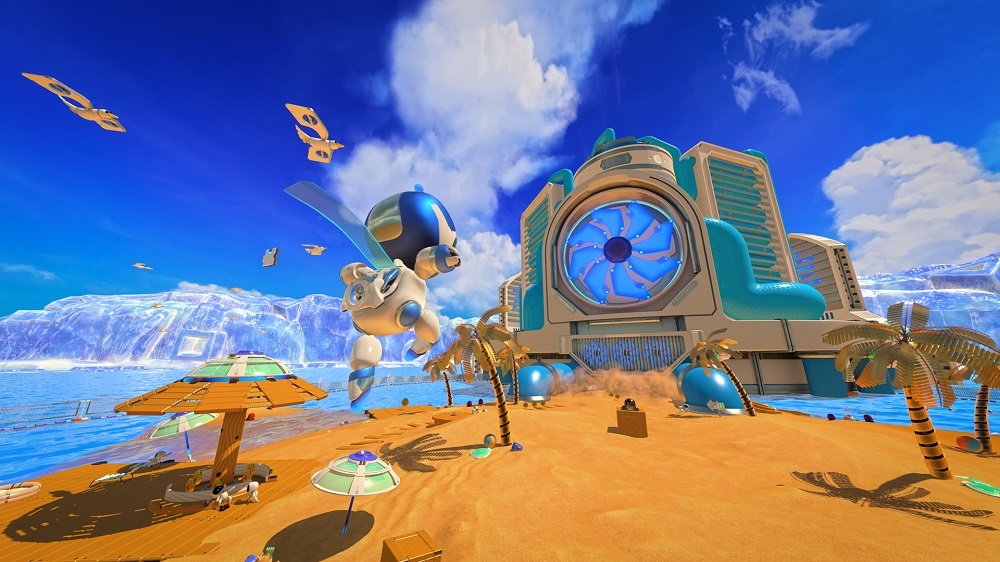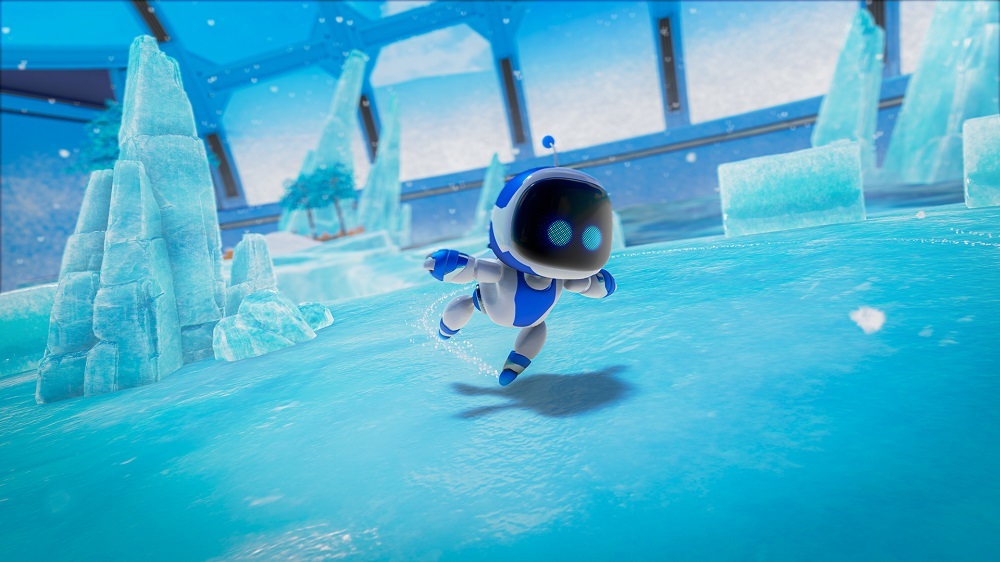Perhaps the first game you'll play when you fire up your new PlayStation 5 is Astro's Playroom, a bright, light platformer that comes bundled with the console. Astro's Playroom isn't an extremely challenging platformer, but it is one with a lot of heart--and a big emphasis on showing you what your new console is capable of delivering. In a big way, your adventure as the robot Astro is a tech demo for the PS5's DualSense controller, as well as a showcase for some spiffy next-generation graphics, and a love letter to PlayStation history.
When you fire up Astro's Playroom, you actually find yourself inside your PlayStation 5, exploring its many components rendered as video game locations. We spent some time in Cooling Springs, one of four sets of levels you can access, and one which represents the PS5's fans and cooling components. Playing into the theme, the first of Cooling Springs' four levels is a beach that sports a giant fan, filled with other robots playing in the water and building sandcastles and enemies wandering around making trouble. Later portions of the level include a section in which you skate across ice floes, bounce across lily pads, and scale platforms in a spring-loaded mech suit.
Each of the sections of Astro's Playroom is about exploration and discovery, with lots of collectibles to track down along the way. The platforming gameplay is pretty similar to what players will recognize in games such as Super Mario Odyssey or Super Lucky's Tale, but it's really much more about using the DualSense to add another layer to what's familiar. Levels are designed to really show off how deeply the DualSense controller's features can be integrated into gameplay.
Astro's Playroom makes heavy use of the controller's haptic feedback capabilities, motion controls, touchpad, and built-in speaker, and occasionally even has you making use of its on-board microphone for gameplay (occasionally, you blow on it to provide the wind to push a pinwheel or move an object). It all feels a bit like what Media Molecule did with the PlayStation Vita and Tearaway, utilizing all the hardware in interesting ways--but which might be more than other developers are willing to spend the time on.
The most impressive thing about Astro's Playroom is definitely the use of the DualSense's haptic feedback. The controller has been redesigned compared to past PlayStation controllers so that the rumble features within are much more refined and sensitive. In Astro's Playroom, the result is that every surface you move across creates a different sensation. Jumping on metal surfaces makes for hard, clicky footsteps; trudging across beach sand is lighter and more spread out to replicate a granular feeling; and skating across frozen blocks of ice creates a thinner, localized sensation to replicate gliding on a thin surface.
The haptics are pretty remarkable, with just about everything in Cooling Springs creating its own specific sensations. Punching enemies, gliding on Astro's jet boots, pulling wires to reveal collectibles, or pushing through the wind tunnel created by a fan all shake the controller in different areas on the device, and in different ways. The DualSense controller is constantly reacting to what's on screen, which helps to add realism to the elements with which Astro is interacting.

Combined with the DualSense's haptics is the on-board speaker, which does a lot of heavy lifting in contextualizing the feelings your controller is giving off. The speaker is responsible for a bunch of small-scale sounds as you move around Cooling Springs--the soft shuffle of sand, the clink of metal footsteps on metal, and the silvery slice of Astro's ice skates all come through the controller along with the haptics. Combining all those sounds with the haptic feedback does a fascinating job of clarifying in your mind what you're feeling through your controller, and together, they add a novel level of immersion to the game.
Another section of Cooling Springs showed off two other aspects of the controller: motion controls and adaptive triggers. Astro dons a robot frog suit that turns him into what is basically a giant spring, bouncing from platform to platform without the ability to walk or run. Coiling the spring is done with the trigger, and how hard you press it determines how big a bounce it creates. You aim Astro by tilting the controller sideways to determine the angle of where he'll go. Haptics help provide the metallic squeeze feeling of the spring; motion controls are pretty similar to what players are used to with Sony's previous controllers.
It's the adaptive triggers that are most interesting, though, as the resistance they provide simulates the force you'd have to exert to squeeze the spring and build up kinetic energy. Squeezing the trigger hard enough to get the most power out of your bounce feels tougher than you'd expect, and maybe even a little tougher than is comfortable, which itself changes the sensation of the move. You feel like you're getting the full power out of the spring as you press harder to coil it, making a fairly common platforming trope--riding a spring across platforms--into a much more satisfyingly tactile experience.
The other exceedingly exciting thing about Astro's Playroom and the Cooling Springs level is the level of love on display for PlayStation history. Hidden throughout the level are pieces of old PlayStation hardware you can discover by solving simple puzzles, venturing into corners off the beaten path, and pulling on cords sticking out of the ground. Find one, and you're treated to a big, 3D model of something like a DualShock controller or EyeToy camera. You can also find various robots like Astro hanging around the level cosplaying famous PlayStation characters in fun little moments happening just off the path as you pass by.

Apart from all the PlayStation love and the heavy use of DualSense technology throughout, Astro's Playroom is just a great-looking little game. Cooling Springs is full of cool water effects filled with splashes and distortions that make the whole area feel a little more real and responsive. It's not exactly mind-blowing, but Astro's Playroom does give you a sense of the fidelity the PS5 is capable of hitting.
Our jaunt through Astro's Playroom was short but sweet and gives a detailed look at some of the gameplay possibilities the PS5 brings to the table for the next generation. The hope is that developers take as much advantage as Team Asobi has of innovative ways to utilize the console's hardware. That's something that was a bit lacking in previous Sony platforms--despite a lot of cool capabilities present in devices like the PS Vita or the DualShock 4 controller, it was rare for anyone other than first-party developers to really lean into using them. Astro's Playroom spends its time laying out just how much the DualSense can do, and those additional features help to make some tight but relatively standard platforming gameplay feel fresh and exciting.

